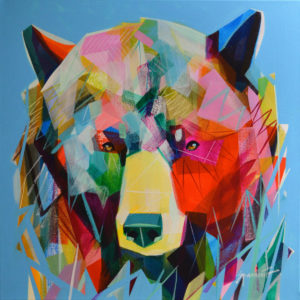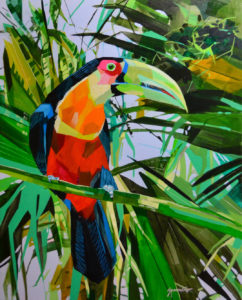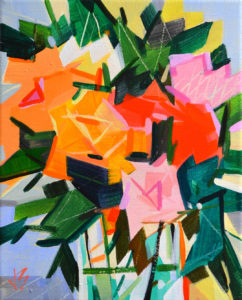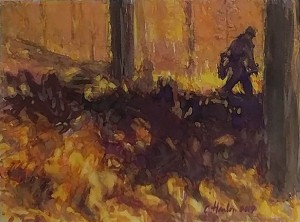Dear Artist,
Jennifer Sparacino of Chilliwack, B.C. wrote, “I have some questions regarding growth as an artist, the changing of subjects and the evolution of one’s “style.” I’ve been primarily painting wildlife since getting into galleries (about eight years now). I have had good success with sales and recognition for my interpretation in this genre. Here’s the rub… I’ve been feeling like a “type-cast actor” for the past couple of years. I can feel my art wanting to grow and change and I’ve dabbled in new works (smaller format) alongside my animals. I’ve shown my galleries these works and although they’re always polite about it, and have even sold a few pieces, the feeling I get is that they just want more of what sells — wildlife — which I totally understand from a business perspective.
I’m curious if you have had this experience yourself or if other artists — wanting to grow and change but feel a bit restricted by current commercial successes. When I look at other artists’ portfolios, especially your Dad’s, it seems he was able to paint what truly moved him, he was a “landscape” artist who also painted many other things and seemed to have a broad enough market to bear his many creative ideas. I feel I’m limited to one.
I want to be as considerate to my galleries and collectors as I pursue possible new horizons, and I’m honestly not sure how to move in new directions. I love the work of Lois Dodd, and I’m also inspired by the ‘everyday’ and the beauty of nature in my immediate surroundings. I’m just not sure how to make this leap into new markets or if I can.”
Dear Jennifer,
Once, when going through a particularly bumpy period of growth, my Dad offered me these words: “It takes courage to stay, and it takes courage to go.” You, your excellent work, your honed and professional style, and your untapped potential are all a profile in courage. You are egg-beatering, with great effort and commitment, in a state of creative, technical and expressive stasis, longing to leap while wondering if this could be the pinnacle of your commercial success as a painter. No one — not you or me, or your gallerists — know if this is it, though you do have some proof of concept that your other subjects can find an audience. First, you need to come to terms with what your current professional status means to you. What is its value, its purpose?
Serving your creativity over your lifetime will not always be the most practical or even a productive path. When faced with my own knowing about when it was time to grow, the decision came easily — it was the execution of the decision that was excruciating, because it brought with it the collateral damage of defying the expectations of others, the thought of endangering their security (and mine), and then living in the terror of the unknown. Are you up for the terror of the unknown? It’s okay if you’re not. Business, your career path, your galleries and your collectors are all vital and precious. Next, you need to ask yourself if there is anything else you deem to be vital and precious. What do you envision your art being, doing and serving for the next 8, 16, 24, 32, 40 and 48 years?
Many artists let the market and their galleries decide who they are and will be. Others, through luck or longing, inspiration or hard work or bravery or some combination of these, have decided for themselves. Carr, Picasso, Monet, O’Keeffe, Dodd. Check the first eight professional years of their work against their last eight. Were there difficulties in arriving there? What, if anything, was sacrificed? Can you trust yourself and others to follow you on your most adventurous, most loving and creatively generous artistic journey? There is no guarantee, and there will always be something worth holding onto. There will also always be something to reach for. “Growth itself,” wrote Pearl S. Buck, “has the germ of happiness.”
Sincerely,
Sara
PS: “Here’s a link to my website. The section called “from the studio” are examples of many of these smaller, experimental works. As you’ll see it varies in style a bit too, but when I paint these… I feel joy.” (Jennifer Sparacino)
“The different styles I have been using in my art must not be seen as an evolution, or as steps towards an unknown ideal of painting. Everything I have ever made was made for the present and with the hope that it would always remain in the present.” (Pablo Picasso)
Esoterica: My Dad experimented with many more styles, media and subjects than you or I ever had the chance to witness. He also understood the importance of professional identity, and in making a commitment to a practice that would give him the creative freedom to grow over a lifetime while also sustaining him with a meaningful professional career. He identified early what his spirit needed within the creative devotion he called his life. He summoned growth, and let growth guide and nourish him. His most experimental work was not always his most commercially successful. His experiments continued until he laid down his brush for the last time. Finally, identify what you truly need to thrive as an artist. You already possess the tools required to not be limited to what you describe as “one creative idea.” Any artist confined to one creative idea serves no one with her calling. “Love dies,” wrote Pearl S. Buck, “only when growth stops.”
“And the day came when the risk to remain tight in a bud was more painful than the risk it took to blossom.” (Anaïs Nin)
Have you considered a Premium Artist Listing? With each letter, an artist is featured at the bottom of this page. The Premium Artist Listings are a means of connecting artist subscribers through their work. Proceeds from each listing contribute to the production of The Painter’s Keys.
“Security is mostly superstition. It does not exist in nature, nor do the children of men as a whole experience it. Avoiding danger is no safer in the long run than outright exposure. Life is either a daring adventure or nothing.” (Helen Keller)
Featured Artist
Christine Hanlon, whose work has been compared to that of Edward Hopper, creates ‘urban landscapes which quietly exude atmosphere.’










40 Comments
Jennifer…Really super work. If you must move on some, don’t totally abandon this.
Thank you, Levi… I plan to keep painting the animals for the foreseeable future :)
Great letters Jenn and Sara. Jenn, we are at the same juncture right now with primarily wildlife in the overlapping Galleries. No gallery wants my nonobjective pieces but I will continue to make them! I have a big storage space.
Thanks Susie, it’s encouraging to know I’m not alone with this one ;). I have lots of storage space too, haha. I find that the smaller works help me in my wildlife paintings too… they’re a place to work out ideas, try different palette combos or just sharpen my ‘seeing’. Cheers to continuing to pursue new ideas!
I know what you are feeling. I was a goldsmith for 40 years. I loved doing custom work but more often than not it was repairs, wedding bands and standard “best sellers” that paid the bills. I changed my thinking from what I wanted to do ….to what gave the customer satisfaction and joy. It freed me up to experiment with designs that would sit in my case for years but that only showed what I was capable of producing. More power to you for finding a style that makes a living for you. You can still let your imagination run wild on things you don’t need to sell. There are thousands of artists who envy your position.
Good advice and very well put. We all need to grow and evolve. Follow your instincts.
Thank you for sharing your story, Joey. It helps to know how other artists and creatives are finding balance with all of this. I can appreciate your comment about other artists who’d love my ‘problem’… and it’s something I think of often: how fortunate I am to be in this position. I certainly don’t take it for granted.
Many thanks Jennifer for your willingness to share your professional dilemma. I resonate with you. Your artwork has good energy and is very inviting. I wish you well on your journey.
I’m also impressed by Sara’s wise and supportive counsel.
Thanks to both of you……. you made my day!
Gwen in Ft. Langley
Thanks Gwen! I’m so glad it resonated with you. Sara is certainly an amazing and supportive counsel too us all :)
Sara, solid support for finding an answer to this challenging question. I particularly like “ Are you up for the terror of the unknown? It’s okay if you’re not.” I would add Richard Diebenkorn to that list of brave painters who found a way to follow their creative drive. I have found that my art is only one of the places where this need for growth has required conscious change. So much so that I have developed language to help myself and others make room for what I must do. I call it the need to reach for my “growing edge” as apposed to what is within my current skills abilities and comfort level. And I negotiate sometimes. Like say “I can give you at least six months or 20 more works of this current subject. If we do this, would you consider showing my new body of work for a further six months to see how it fairs?” Pissarro was also a thoughtful experimenter and at one point his market and art dealer were terribly disappointed with what he was doing. But Pissarro worked through his process and came part way back to what he had been doing stronger than ever. There is no right or wrong so I oftentimes ask myself – what will matter 10 years from? This sometimes gives me a clue in which direction my heart will lead my common sense into action.
Terrill, thank you for sharing your insights… lots for me to think about and I also love the work of Diebenkorn… I will take a gander through some books of his to refresh my knowledge of his artistic journey.
“Success is about the worse thing that could happen to a painter.”
Vincent van Gogh
Jennifer, your work is beautiful, fun, colorful and mesmerizing. I found your brand. It is obvious in all your work, whether animals or floras. Your style is recognizable. You could show all your subjects in one show and people would recognize your work. Go for it and be brave and have fun!
Thank you, Valerie. I appreciate your support and kind words about my art. Sometimes I feel too ‘close’ to get truly objective about my work… I appreciate you finding my ‘brand’ among it all. :)
I believe every part of creation has a soul or that our own spirit, through the great Spirit, can connect with that dynamic essence. If you can imagine each of your subjects like an animal, with It’s own spirit, then the connection will spring out from the canvas just like your animal portraits do.
Gillian, your words really resonated with me here about finding the ‘soul’ of each subject, regardless if fauna or flora. When I completed my ‘veggies’ series I actually noticed how I found the spirit of the subject in the same way as I do with my animals… a small bunch of beets or radishes had the same impact and ‘aliveness’ as did a large bear or bison. Thanks for sharing your insights.
Ah, yes, familiar feelings we most likely all experience along the way as artists. Jennifer’s work is all done in a wonderful individual style that is of her own signature. The differences in them is subject. I wonder to myself often, is it the subject that our buyers are swayed by, or our style in how we paint? I’ve witnessed successful artists who change mediums and suffer reduced sales. I’ve watched artists venture into different subject matter, and complain they don’t sell. For myself, I’m less adventurous in going to the studio to paint something that probably won’t do much other than satisfy a bit of rebellious adventure “just because” I was in that mood. I like sales. I am thankful for each and every one of them. I get tired of sticking to the stream of series thing, but never get tired of sales, so I keep on. There is always a shift in what we paint, an evolving without really being aware of it. We grow in spite of ourselves.
Thank you, Mary Ann. I’ve often thought the same thing… do buyers respond to the style or subject more often? I’ve heard directly from clients that both things are what they are swayed by. I have collectors who have reached out to me and shared that they have bought both my animals and flowers/other subjects. Some have said that it’s ‘how’ I paint regardless of subject, others have said it’s based purely on how each individual painting moves them… sometimes it’s a bear, sometimes a bunch of beets. :)
It’s always that battle inside of us whether we paint what others want, or what we feel like painting. Of course we are influenced by what our galleries ask for, they are out there on the business side hearing collectors comments based on sales. Of course we are influenced by what others say… “Paint the trees, they move me so” we don’t like admitting we are influenced by what the viewers see and say, but we are anyways. This was why I abandoned all organizations that had juried shows and community opinion. I was painting what others told me to paint. I am fortunate to have a gallery that doesn’t sway me in any way as to what to bring in. But still, I know what buyers like, so I pretty much stick to that kinda thing. :)
Ha …ha …ha “…sometimes it’s a bear, sometimes a bunch of beets”. When I looked at your beautiful work Jennifer, I immediately thought that your style would attract me, no matter the subject. My path has been one of safety – I taught for many years and am now able to be indulgent.
Are you limited to selling in the galleries? I know of others who have changed ‘genre’ and gone on-line with that body of work: now they are selling almost exclusively (and very successfully) on-line. Whatever you choose, I wish you the very best as you find your way forward.
Thanks Linda :), I believe in the gallery model for many reasons, mostly because it allows me more time to actually paint rather than manage the business side of things ( I know my limitations haha). Regarding selling direct online… I’ve tried this a little in the past year with my ‘from the studio’ works. Because I sell at my gallery price–if I do sell direct– I found that often I’d quote a price and not hear back from people (maybe galleries find this too?). Ultimately, I hope to be able to paint until I take my last breath. I’m in this for the long-haul and I believe that when we work with integrity-driven galleries, everyone wins… artists, galleries and clients. :)
Sara
You mention how your Dad worked with a multitude of styles,media and subjects.
I recall visiting him one day and found him painting on small sheets of glass.
He was planning t make prints from these.Unfortunately I never did see the results.
I’ve known artists that use a different gallery to show their alternative style works. Often galleries themselves only show and sell a particular style of art—-classic, traditional styles——abstract and modern—etc., and have a clientele that likes the style they carry. Perhaps it’s not that they don’t love your new style, but that’s not what the gallery is known for. Find a new gallery to carry your new art.
Hi Kathryn, thanks for your comment. I’ve often wondered this as well, should I find a secondary market with a new gallery/galleries alongside my current market? And I agree, I believe the galleries have to be vigilant to keep their markets strong for all involved, so carrying what has a strong selling market is vital. Time will tell, I suppose as to where my ‘unestablished’ market will end up.
Hi Jennifer, I admire your great sense of colour and design. I see something truly unique in how you present nature and wildlife and the abstraction in your work. I also look forward to seeing what comes from your “expeditions” into the “wilderness” of new paintings…May you take your creativity with you. Wishing you continued success.
Thank you, Jane! I appreciate your kind words and support as I journey forth. ;)
The beets are certainly as good as the animals and the style carries through. I think it is more unusual to paint animals like you do. I see many artist who do the still life work in a similar way. Maybe that’s what the gallery is seeing? That the animals are unique, but the fruit/flowers are not? All is very good and you do have a wonderful style. If you are ready to modify your subject, then you have to, maybe incorporate flowers/fruit/veg in with the animals to build a bridge?
Thanks Rebecca, I think you’re on the right track with your comments about the wildlife being more unique. I agree that this is my ‘edge’, if you will, and perhaps the idea of ‘bridging’ subjects may be something I try. I know the other subjects are more common. I remind myself of something Robert said once when someone stopped by to comment on the landscape he was painting plein air… ‘it’s been done before’. Robert wrote that he said nothing at the time but later it hit him… ‘yeah, but not by me’. I love the reminder that it’s ‘all been done before’ but it’s how we approach it with our unique voice and skill sets. I hope I can continue to give viewers something unique while being true to my vision and honouring the natural process of creative evolution.
Hi Jennifer, The wildlife paintings evoked an emotional response in me. I felt a connection. I connected to the beets and paper bag as well. I believe painting is a communication between the viewer and the artist. In both cases I felt that connection. The flowers did not speak to me. I love flowers and am fond of making flower arrangements. In this case, it is not about the subject, for me. Perhaps, in taking another step you consider carrying your emotional expression of the animals looking straight at the viewer into a different style, subject or medium. For me, a painting has to speak to me. I need to feel something. What are you trying to communicate to the viewer? I understand how you can become burned out painting several variations on the theme. I am glad that you are aware of developing yourself further with the confine of the commercial. I wish you well.
Thank you for your insights, Enid. I’m glad the beets spoke to you :). I agree with you that there could be further development and evolution with my wildlife too. It’s something I think about often, and we’ll see what happens.
Great discussion here. Jennifer, I think of Philip Guston who made a change in what he painted and at the time took a lot of criticism from many including other artists. He was successful in both realms. I think the work itself helps in your decision making.
Thank you, Nancy. As Sara points out… it can be terrifying to think of charting new waters creatively. So much feels at stake. Another gem of Robert’s he shared many times was that ‘quality is always in style’. I know ‘quality’ can feel nebulous and highly subjective… but I’m learning to trust my instincts… to let my feelings of quality steer the ship.
I kind of have the opposite problem. I work in different media and have different subjects. I don’t want to be limited to any one thing. I feel like that may be hurting me. I’m told I need a cohesive body of work to show in galleries. Right now I figure what’s the point if I can’t do what makes me happy and fulfilled as an artist?
Jennifer, thank you for your question. It has come at a critical time for me and the question and the response have helped me tremendously. It hasn’t solved a problem but it has validated my need to explore the path I’m on.
Hi Sharon, I’m so glad this letter resonated with you! It’s helpful to know others are on similar paths with similar challenges. Being an artist tends to be solitary. I find supportive communities such as Painter’s Keys have been a vital contribution to this path.
Many years ago, long before I was an artist, I was part of a young business people’s advisory group to the Royal Bank. As part of that I received quarterly and yearly studies. After a while I was struck by how sensible their backward looking analysis were, and how consistently wrong their predictions were. Yes we are frightened by change, especially if driven from within. But just live with denying it. I wouldn’t want to for long.
Hi Hugo, thank you for sharing your experience. I know what you mean… denying the impulse to grow and change is tough. No easy answers, but lots to reflect on and consider. :)
Possibly market your new work at new galleries?
Hi Nicole, I’ve wondered this also. I feel I should build up more work in this new genre alongside my wildlife and check in with my current galleries first to give them ‘first dibs’. Maybe then, it will be clear that a new gallery and market might be the ticket. Thanks for your thoughts… so much to consider.
Pingback: Transitions Can Be Tough | Pat Katz - Optimus Consulting - Growing Your People In Value & Worth